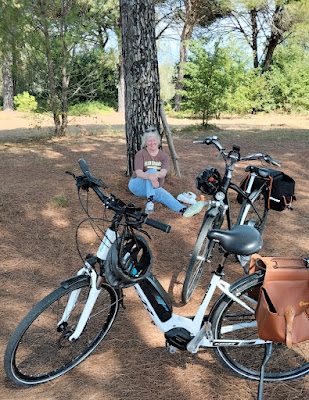“An American Family in Italy,” published in 2015, gives an account of a year our family spent in Padova, Italy, in 2001-02. Also in 2015, we bought a home in the hilltop village of Montecarlo, in Northern Tuscany. One would think that with eight years of experience living off and on in Italy that by now I would have written a second book detailing the joys and tribulations of living La Dolce Vita as an Italian citizen and resident. I’ve blogged about it extensively, so how much effort would it take to transform those blog entries into a book?
Apparently, too much, because the second book is still
far from reality, and I don’t much care. It turns out that it’s way more fun living
the sweet life than it is to go through the pain of editing, formatting, designing
a cover and marketing. Especially marketing.
 |
| Matt and Zeneba in their new town of Soriano Nel Cimino, about an hour north of Rome. |
So if you really want to read about our experiences in Tuscan living, start in the early years of my blog and read on. You can skip past the boring entries about my genealogical discoveries. But if you want to instead read a paperback or e-book about the process of buying a house and moving to Italy, I can recommend several very good ones already in print. One recently published account is by Matt Walker and Zeneba Bowers, who sold almost all their possessions in the United States and moved to Soriano in Lazio at just about the same time that Covid-19 struck hard in all of Italy, adding to the already difficult process of starting a new life.
The book is titled “I Can’t Believe We Live Here: TheWild But True Story of How We Dropped Everything in the States and Moved toItaly, Right Before the End of the World.” Despite the long title, the book is
a pleasant and easy read at 159 well-written pages.
 |
| Almost every evening during the lockdown, Matt & Zeneba serenaded neighbors from their balcony. |
Zeneba and Matt are accomplished concert musicians,
and now they organize and perform concerts in Italy. They also run a travel business
called LittleRoadsEurope.com, have published four guidebooks and create
itineraries for clients.
On their website, they write “Our vast base of
knowledge of affordable but luxurious lodgings, authentic eateries, and
little-known, off-the-beaten-track sights has enabled us to craft hundreds of
itineraries for travelers. Most of our travelers are honeymooners, couples on
their anniversary trips, and families wanting their kids to experience a ‘real’
Europe that the big tourist crowds miss. We work with each client personally
and extensively, to create custom itineraries for all types of small groups
with different travel objectives. Wherever we go, our goal is to fit in with
the locals in the town; to experience life there beyond the surface one might
find as a random tourist; to slow down and take time to actually see and
experience what is around us; and to learn about the food, culture and history
of the area—all without getting bogged down in the big tourist crowds.”

.jpg)





.jpg)







.jpg)





















